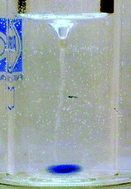A procedure for the determination of ultratraces of lead and cadmium by liquid-phase microextraction based on solidification of a floating organic droplet (LPME-SFO) separation and electrothermal atomic absorption spectrometry (ETAAS) has been developed. For this purpose, 50 μL of pre-heated (50 °C) undecanoic acid (UA) are added to 25 mL of aqueous sample solution at pH 5. The mixture, maintained at 50 °C, is stirred at 1000 rpm for 10 min and then the vial is immersed in an ice-bath, which results in the solidification of the UA drop that is easily separated. Injection into the atomizer is carried out after a gentle heating. By impregnating the atomizer with tungstate as a permanent chemical modifier, the detection limits were 10 and 0.5 ng L−1 with enrichment factors of 380 and 420, for lead and cadmium, respectively. The relative standard deviation was in the 2.8–3.2% range (n = 5, 25–400 ng L−1 Pb(II) and 1–15 ng L−1 Cd(II)). The proposed method has been applied to the determination of lead and cadmium in bottled, tap and sea water samples, the reliability of the results being verified by means of recovery tests and by using ICP-MS.

You have access to this article
 Please wait while we load your content...
Something went wrong. Try again?
Please wait while we load your content...
Something went wrong. Try again?


 Please wait while we load your content...
Please wait while we load your content...